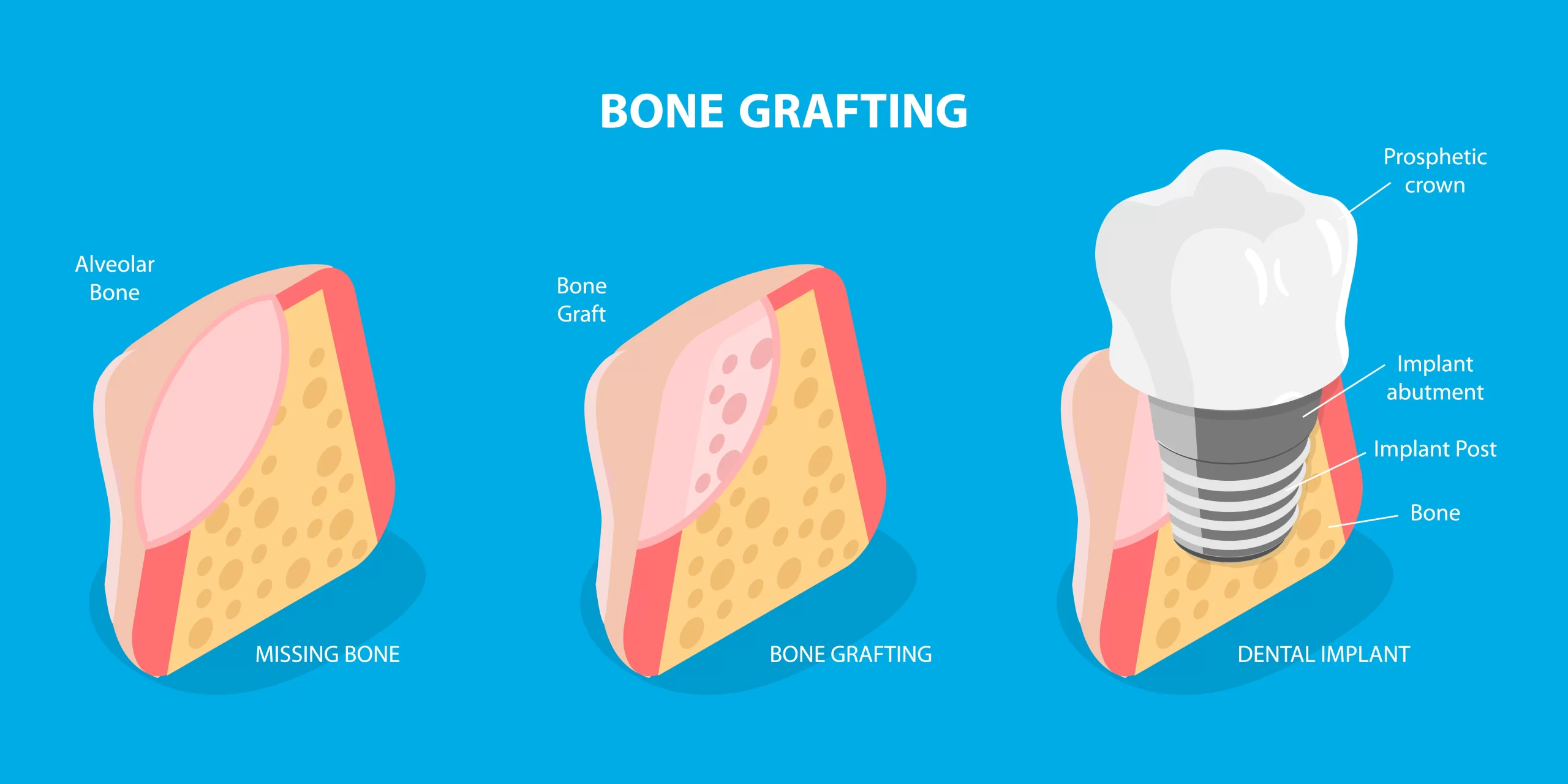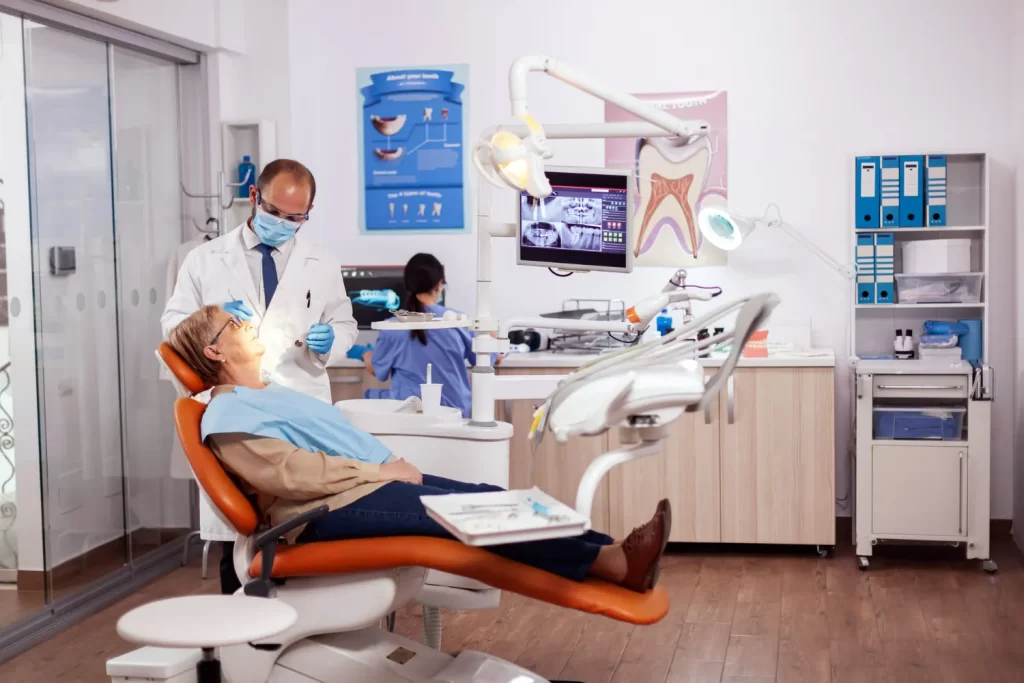Understanding Dental Bone Grafts

A dental bone graft is a surgical procedure used to replace or augment bone in the jaw, typically to support dental implants or to address bone loss resulting from injury, disease, or prolonged tooth loss. The procedure involves placing bone material into the jawbone to encourage new growth and restore strength.
The grafted bone may be sourced from the patient, a donor, an animal, or synthetic material. Over time, the graft integrates with the patient’s natural bone, providing a stable foundation for future restorative treatments.
What Is a Dental Bone Graft and How Does It Work?
A dental bone graft increases the volume and density of the jawbone in areas where bone loss has occurred due to:
- Gum disease
- Tooth loss
- Trauma or injury
- Medical conditions affecting bone density
The bone graft material acts as a scaffold, stimulating the body’s natural healing process. Once healed, the jawbone is ready to support a dental implant, denture, or other restorative solution.
Why a Dental Bone Graft Is Needed Before Getting Dental Implants
Dental implants must be anchored securely into the jawbone. When there isn’t enough bone to support the implant, grafting becomes necessary.
Common reasons for bone grafting include:
- Tooth extraction with delayed implant placement
- Jawbone thinning from long-term denture wear
- Bone loss due to advanced periodontal disease
- Preparation for complex implant cases like All-on-4
Bone grafting also helps maintain facial structure and avoid the sunken appearance often caused by missing teeth.
Types of Dental Bone Graft Materials Used in Australia
There are several graft material options commonly used by Australian dental professionals:
- Autograft – Harvested from the patient (e.g. jaw, hip); high success rate but requires a second surgical site
- Allograft – Sourced from human tissue donors; processed to ensure safety and sterility
- Xenograft – Animal-derived material, typically bovine, treated to remove organic elements
- Alloplast – Synthetic material like calcium phosphate or bioactive glass
Autografts are often considered the gold standard due to compatibility, but allografts and alloplasts are popular for their convenience and low morbidity.
Guided Bone Regeneration vs Traditional Dental Bone Grafting Methods
Guided bone regeneration (GBR) is a technique used to enhance bone growth. A protective membrane is placed over the graft material to prevent soft tissue from invading the site, allowing bone to regenerate undisturbed.
When Is GBR Used?
- In cases of severe bone volume loss
- When placing implants in compromised bone sites
- To promote faster and more predictable healing
GBR is widely used in modern implantology and is particularly beneficial in complex treatment plans that require precision.
What Happens During a Dental Bone Graft Procedure
The grafting procedure is usually done under local anaesthesia and follows these general steps:
- A small incision is made in the gum to expose the jawbone
- The graft material is placed in the targeted area
- A membrane may be added to protect the graft (if using GBR)
- The site is closed with stitches, and healing begins
The appointment typically lasts 45–90 minutes, depending on complexity. Patients are discharged the same day with post-op care instructions.
Socket Preservation After Tooth Extraction
Socket preservation is a specific type of bone graft placed immediately after tooth removal. Its purpose is to maintain the natural shape of the bone and gum, especially when future implant placement is planned.
This approach is especially beneficial when:
- There are plans for single-tooth implants
- Minimising bone loss is a priority
- Aesthetic contouring of the gum is needed
The socket is filled with graft material and sealed with a membrane or collagen plug, preserving the ridge for future treatments.
Sinus Lift Procedures for Upper Jaw Implants
When implants are needed in the upper back jaw, there may not be enough bone height due to sinus proximity. A sinus lift may be necessary to create room for grafting.
Sinus Lift Techniques:
- Lateral window – Bone is added through a small opening on the side of the sinus wall
- Crestal approach – Minimally invasive method performed from the implant site
This procedure increases vertical bone height and ensures long-term stability of upper jaw implants.
Platelet-Rich Plasma and Modern Grafting Technologies
Some dental clinics use platelet-rich plasma (PRP) or platelet-rich fibrin (PRF) to enhance healing. These are derived from the patient’s blood and added to the graft site.
Benefits of PRP/PRF:
- Faster healing
- Reduced inflammation
- Lower post-operative discomfort
Though optional, these technologies are popular in complex or multi-site grafting cases.
Recovery Timeline After a Dental Bone Graft
Healing time varies based on graft size and individual healing factors. Most people resume normal activities within 24–48 hours, but bone regeneration may take several months.
Recovery Milestones:
- First 48 hours – Swelling, minor discomfort
- 1 week – Soft tissue healing; stitches may be removed
- 3–6 months – Graft fuses with natural bone; site becomes implant-ready
Follow-up appointments and imaging ensure proper integration before proceeding with implant placement.

Possible Risks and Complications of a Dental Bone Graft
As with any surgery, complications may occur, but are rare. According to the Cleveland Clinic, risks include:
- Infection at the graft site
- Graft failure or rejection
- Nerve irritation in the lower jaw
- Sinus issues in upper jaw grafts
Strict adherence to post-op care guidelines significantly reduces these risks.
Nutrition and Lifestyle for Better Healing
Proper nutrition and lifestyle choices help promote optimal recovery:
- Calcium-rich foods – Support bone mineralisation
- Vitamin C and D – Aid in bone and soft tissue repair
- Hydration – Helps cell repair and immune function
- No smoking – Smoking can delay healing and raise the risk of graft failure
Avoid hard or sticky foods and follow oral hygiene instructions during the healing period.
Cost and Insurance Considerations in Australia
Costs vary depending on procedure type and graft material:
- Simple bone graft – $600–$1,200 per site
- Sinus lift or complex graft – $2,000 or more
Some private insurance providers may cover part of the cost if the graft is medically necessary. Always ask for a treatment plan with item codes for clarity.
Long-Term Care After a Dental Bone Graft
Protecting the grafted area ensures long-term success. This includes:
- Scheduling regular dental check-ups
- Avoiding trauma or pressure on the grafted site
- Practising proper oral hygiene daily
- Committing to implant maintenance once placed
Preventive care plays a vital role in the success of the graft and future restorations.
Final Thoughts

A dental bone graft can restore essential bone structure and prepare your jaw for life-changing dental implants. When performed by experienced professionals and followed by consistent aftercare, the results can be long-lasting and transformative.
If you’re considering dental implants but have been told you don’t have enough bone, Dr. Bobby Chhoker and his team can guide you through the process with precision and personalised care.
To take the next step toward restoring your smile, book a consultation today and explore your options with an experienced team committed to your oral health.
